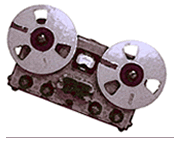


|
The choice of vocal material as a reference point in this piece produces an abstract presence which is never grasped, always assumed, endlessly sought and ever non-existent. With the "disembodied" vocal synthesis, there is a "voice," but no singer. There is only a corpus of material which is terribly abstract, but which retains a physical link with every listener. The reference to vocal material has real mimetic value: on one hand it provides schemes for organization of material which we may draw upon, transform and anamorphize; on the other hand, it is a carrier of meaning, furnishing a real learning experience for the imagination and perceptions. The work on timbre is essentially based on the compression and expansion of formants or spectral envelopes, by departing from vocal types of material and deviating from these models towards others, with or without references to musical families of instrumental timbres. These models and their deviations provide a great homogeneity of material despite the fact that there is constantly a wide variety of transformations in the texture. The sound synthesis was made with the CHANT program at IRCAM, which is a program for synthesis through rules, based on the model of vocal production. Developed by Xavier Rodet and Yves Potard, it uses a library of "instruments," which are materials centered around the voice, but also departing from it. These include all families of instruments like strings, winds and percussion, and "instruments" more distant from existing instrumental references. Though the sonic materials have been carefully worked out, special attention in this piece is given to organization. The research on musical processes, their fields of action and their limits, has been thought of as a strategy for approaching the musical territory as it is renewed by the possibilities made accessible through the use of computers. |
The types of processes in the piece are concerned with the phenomena of change, of transition, or of trajectories defining lines between points, structured formally and in time. These trajectories are strategies for the exploration of a terrain, designed to invade the sound space in all of its dimensions. Based on these processes, the piece navigates through libraries or structured lists of values for parameters such as frequency, amplitude, duration, vocal phonemes (which basically describe spectral envelopes) and the compression/expansion of formant frequencies. The beginning of the piece employs processes that reveal the development of the timbre at different harmonic and melodic levels according to the compression/expansion of spectral envelopes based on vocal phonemes. This leads to an ostinato section also controlled by processes at various levels, and in the latter portion of the piece these processes produce a slow ascent in a synthesized vocal choir, which becomes increasingly rapid and high, rounded off by a gong-like stroke that dissolves into a distant choir. Compositional structures as well as scores were elaborated in the FORMES programming environment, with the help of Pierre Cointe and Yves Potard. Developed by Xavier Rodet, Yves Potard and Pierre Cointe, FORMES is essentially devoted to the development and manipulation of structures in time. A number of elaborate rules describing the behavior of the different parameters was defined to generate evolutions for the internal, or microscopic, structure of sounds. The macroscopic structure was managed through various processes interacting at different levels of organization, controlling pitch, rhythmic, metric and timbral structures. For instance, libraries of selected values for a given parameter were first built in FORMES; complex patterns were written that were used to "read" these libraries, and then calculate the values for a given sequence. The resulting data was then sent to CHANT for sound synthesis. Chréode won the Prix de la Musique Numerique of the Concours International de Musique Electroacoustique of Bourges 1983. It is dedicated to the CHANT/FORMES project and to Kaija Saariaho. |